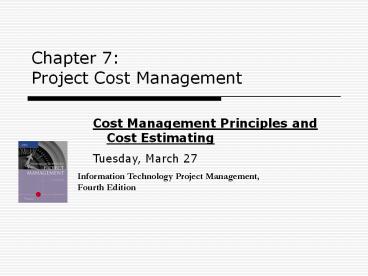Chapter 7: Project Cost Management - PowerPoint PPT Presentation
Title:
Chapter 7: Project Cost Management
Description:
Information Technology Project Management, Fourth Edition. 3 ... that when many items are produced repetitively, the unit cost of those items ... – PowerPoint PPT presentation
Number of Views:125
Avg rating:3.0/5.0
Title: Chapter 7: Project Cost Management
1
Chapter 7Project Cost Management
Cost Management Principles andCost
Estimating Tuesday, March 27
Information Technology Project Management,Fourth
Edition
2
Todays Schedule
- Test 2 Mean80Median84
- Chapter 7 Cost Management
- Importance
- Basic Principles
- Estimating Techniques
3
Learning Objectives
- Understand the importance of project cost
management. - Explain basic project cost management principles,
concepts, and terms. - Discuss different types of cost estimates and
methods for preparing them.
4
The Importance of Project Cost Management
- IT projects have a poor track record for meeting
budget goals. - The 2003 CHAOS studies showed the average cost
overrun (the additional percentage or dollar
amount by which actual costs exceed estimates)
was 43 percent. - U.S. lost 55 billion in IT projects in 2002 from
cancelled projects and overruns compared to 140
billion in 1994. - The Standish Group, Latest Standish Group
CHAOS Report Shows Project Success Rates Have
Improved by 50, A Standish Group Research Note
(3/25/03).
5
What is Cost and Project Cost Management?
- Cost is a resource sacrificed or foregone to
achieve a specific objective, or something given
up in exchange. - Costs are usually measured in monetary units,
such as dollars. - Project cost management includes the processes
required to ensure that the project is completed
within an approved budget.
6
Project Cost Management Processes
- Cost estimating Developing an approximation or
estimate of the costs of the resources needed to
complete a project. - Cost budgeting Allocating the overall cost
estimate to individual work items to establish a
baseline for measuring performance. - Cost control Controlling changes to the project
budget.
7
Basic Principles of Cost Management
- Most members of an executive board have a better
understanding and are more interested in
financial terms than IT terms, so IT project
managers must speak their language. - Profits are revenues minus expenses.
- Life cycle costing considers the total cost of
ownership, or development plus support costs, for
a project. - Cash flow analysis determines the estimated
annual costs and benefits for a project and the
resulting annual cash flow.
8
Cost of Software Defects
It is important to spend money up-front on IT
projects to avoid spending a lot more later.
Collard, Ross, Software Testing and Quality
Assurance, working paper (1997).
9
Basic Principles of Cost Management
- Tangible costs or benefits are those costs or
benefits that an organization can easily measure
in dollars. - Intangible costs or benefits are costs or
benefits that are difficult to measure in
monetary terms. - Direct costs are costs that can be directly
related to producing the products and services of
the project. - Indirect costs are costs that are not directly
related to the products or services of the
project, but are indirectly related to performing
the project. - Sunk cost is money that has been spent in the
past when deciding what projects to invest in or
continue, you should not include sunk costs.
10
Basic Principles of Cost Management
- Learning curve theory states that when many items
are produced repetitively, the unit cost of those
items decreases in a regular pattern as more
units are produced. - Reserves are dollars included in a cost estimate
to mitigate cost risk by allowing for future
situations that are difficult to predict. - Contingency reserves allow for future situations
that may be partially planned for (sometimes
called known unknowns) and are included in the
project cost baseline. - Management reserves allow for future situations
that are unpredictable (sometimes called unknown
unknowns).
11
Cost Estimating -- What Kind??
- Project managers must take cost estimates
seriously if they want to complete projects
within budget constraints. - Its important to know the types of cost
estimates, how to prepare cost estimates, and
typical problems associated with IT cost
estimates.
12
Types of Cost Estimates
13
Cost Management Plan
- A cost management plan is a document that
describes how the organization will manage cost
variances on the project. - A large percentage of total project costs are
often labor costs, so project managers must
develop and track estimates for labor.
14
For Thursday, March 29
- Read Chapter 7
- On TIME Delivery of Team Milestones































